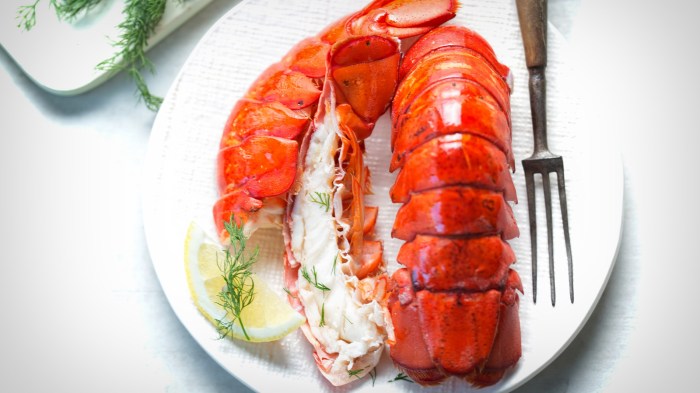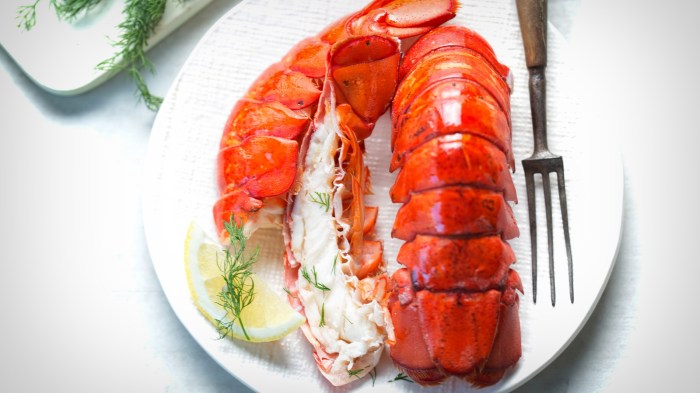
Lobster Tails Steamed in Beer: A Culinary Delight
Lobster tails steamed in beer take center stage, offering a symphony of flavors that tantalize the palate. This method of cooking brings out the natural sweetness of the lobster while adding a subtle, yet distinct, beeriness that elevates the dish to new heights.
From the cultural significance of lobster tails to the science behind the beer’s role in enhancing flavor, we’ll explore the intricacies of this culinary masterpiece.
Imagine the aroma of steaming lobster tails mingling with the intoxicating scent of your favorite brew. This dish is more than just a meal; it’s an experience that transports you to a world of culinary indulgence. Whether you’re a seasoned foodie or simply looking for a new way to enjoy this seafood classic, steaming lobster tails in beer is an adventure worth embarking on.
The Allure of Lobster Tails
Lobster tails are a culinary delicacy prized for their succulent meat, delicate flavor, and impressive presentation. The appeal of lobster tails lies in their unique combination of taste, texture, and cultural significance.
Cultural Significance of Lobster Tails
Lobster tails have held a prominent place in culinary traditions and cultural celebrations across the globe. In North America, lobster tails have been a staple of coastal communities for centuries, often associated with special occasions and celebratory meals. The lobster industry has played a significant role in the economies of coastal regions, particularly in New England, where lobster fishing and processing are integral to the local culture.
- In France, lobster tails are a celebrated ingredient in haute cuisine, featured in classic dishes like Lobster Thermidor and Lobster Bisque. Lobster tails are often served in elegant restaurants and are considered a symbol of luxury and refinement.
- In Japan, lobster tails are prized for their delicate flavor and are frequently used in sushi and sashimi. Lobster tails are often presented as a symbol of good fortune and prosperity in Japanese culture.
- In China, lobster tails are a popular ingredient in Cantonese cuisine, often prepared in stir-fries and steamed dishes. Lobster tails are seen as a symbol of wealth and abundance in Chinese culture.
Historical Accounts and Anecdotes
The history of lobster tails is intertwined with the development of fishing technologies and the evolution of culinary practices.
- Early accounts of lobster fishing date back to the 17th century, when lobsters were considered a common food source for coastal communities. The abundance of lobsters led to their use as bait for cod fishing, and their meat was often used in stews and soups.
- The rise of the canning industry in the 19th century allowed for the preservation and distribution of lobster tails, making them more accessible to consumers beyond coastal regions. This increased demand for lobster tails led to the development of more sophisticated fishing techniques and the expansion of the lobster industry.
- In the 20th century, lobster tails became a symbol of luxury and status, particularly in the United States. This shift in perception was influenced by the growing popularity of fine dining and the increasing availability of frozen lobster tails. The association of lobster tails with luxury and exclusivity has continued to this day.
The Art of Steaming
Steaming lobster tails is a simple yet elegant cooking method that allows the natural flavors of the lobster to shine through. It’s a technique that yields succulent, tender meat and is surprisingly easy to master.
Steaming Lobster Tails in Beer
Steaming lobster tails in beer adds a unique depth of flavor and aroma. The beer’s gentle heat helps to infuse the lobster with its malty, hoppy notes, creating a symphony of taste. The process is simple: place the lobster tails in a steamer basket, add your chosen beer to the bottom of the pot, and steam until cooked through.
Benefits of Steaming Lobster Tails in Beer
- Flavor Infusion:The beer’s aromas and flavors infuse the lobster, creating a complex and satisfying taste.
- Tenderness:Steaming cooks the lobster gently and evenly, resulting in tender, succulent meat.
- Moisture Retention:The steam helps to lock in the lobster’s natural moisture, preventing it from drying out.
- Simplicity:Steaming is a straightforward cooking method that requires minimal effort and cleanup.
Comparing Steaming to Other Cooking Methods
Steaming lobster tails offers several advantages over other cooking methods:
- Boiling:While boiling is a common method, it can result in overcooked and rubbery lobster. Steaming, on the other hand, provides a more delicate and even cooking process.
- Grilling:Grilling can produce a smoky flavor, but it can also lead to uneven cooking and dryness. Steaming offers a more controlled and consistent cooking experience.
- Baking:Baking lobster tails can be time-consuming and may not achieve the same level of tenderness as steaming.
The Beer Factor: Lobster Tails Steamed In Beer
The magic of beer in steaming lobster tails lies not just in its ability to create a moist and flavorful environment but also in its intricate interplay with the lobster’s delicate flavors. The beer’s components, through a series of chemical reactions, enhance the natural sweetness of the lobster meat and add subtle notes of malt and hops.
The Science Behind the Flavor
The beer’s contribution to the steaming process goes beyond mere moisture. The key lies in the interplay of the beer’s components with the lobster’s proteins and sugars.
Lobster tails steamed in beer are a classic for a reason – the delicate flavor of the lobster is perfectly enhanced by the subtle maltiness of the beer. But if you’re looking for a heartier, more rustic option, you might want to try slow cooker baby back ribs.
The slow cooker method allows the ribs to fall off the bone, while the rich sauce adds a depth of flavor that’s hard to resist. Of course, if you’re looking for a more elegant seafood option, you can’t go wrong with those perfectly steamed lobster tails!
The beer’s sugars, primarily maltose and glucose, break down during steaming, contributing to the overall sweetness of the dish.
Lobster tails steamed in beer are a classic comfort food, especially when paired with a side of creamy mashed potatoes. The subtle sweetness of the beer adds a depth of flavor to the delicate lobster meat. Of course, no meal is complete without a hearty soup, and for me, nothing beats Oma’s fabulous matzo ball soup found here.
The combination of the rich, savory lobster tails and the comforting warmth of the soup is a true culinary delight.
The hops, known for their bitterness, add a subtle complexity to the flavor profile.
The hops’ bitterness balances the sweetness of the lobster and the beer, creating a harmonious flavor.
The yeast, present in the beer, contributes to the overall aroma and adds a hint of fruity notes, further enhancing the complexity of the dish.
Beer Styles for Lobster Tails
The choice of beer is crucial for achieving the perfect flavor balance. Here’s a glimpse into the world of beer styles that complement the taste of lobster tails:
Lagers:Crisp and clean, with a light body and subtle malt flavors, lagers like Pilsner or Vienna Lager provide a refreshing counterpoint to the richness of the lobster.
Pale Ales:These beers offer a balanced profile of malt and hops, creating a harmonious blend with the lobster’s sweetness and natural flavors.
Wheat Beers:Their light, refreshing flavors, often with hints of banana or clove, pair beautifully with the delicate sweetness of lobster meat.
Stouts:These dark and rich beers, with notes of coffee and chocolate, offer a bold contrast to the lobster’s sweetness, creating a unique and complex flavor experience.
Preparing the Perfect Lobster Tail

The journey to succulent, steamed lobster tails starts long before they hit the pot. Choosing the right lobster tails and preparing them properly is crucial for achieving the perfect texture and flavor.
Selecting Fresh Lobster Tails
The freshness of the lobster tails directly impacts their taste and texture. Fresh lobster tails have a bright, almost translucent appearance, with a firm, springy texture. They should smell slightly sweet and briny, with no signs of discoloration or unpleasant odors.
Preparing Lobster Tails for Steaming
Here’s a step-by-step guide for preparing lobster tails for steaming:
1. Thaw Frozen Lobster Tails
If using frozen lobster tails, thaw them in the refrigerator overnight. Avoid thawing them at room temperature as this can promote bacterial growth.
2. Clean the Lobster Tails
Rinse the lobster tails under cold water and pat them dry with paper towels.
3. Remove the Intestines
Lobster tails steamed in beer are a classic for a reason – the delicate sweetness of the meat pairs perfectly with the malty, slightly bitter notes of the beer. But you know what really elevates the dish? A dollop of fiery, smoky red ribbon roasted salsa ! The bright acidity cuts through the richness of the lobster, while the smoky depth adds another layer of complexity.
The combination is truly a match made in seafood heaven.
If you’re using whole lobster tails, use a sharp knife or kitchen shears to cut along the underside of the tail, from the tail fin to the body. Remove the dark vein (intestine) that runs along the center.
4. Season the Lobster Tails
Season the lobster tails with salt, pepper, and any other desired spices. You can also add a squeeze of lemon juice for extra flavor.
5. Tie the Lobster Tails
Tie the lobster tails with kitchen twine to keep them compact during steaming.
Steaming Time for Different Lobster Tails, Lobster tails steamed in beer
The steaming time for lobster tails depends on their size and type. Here’s a table showcasing different types of lobster tails and their ideal steaming times:| Type of Lobster Tail | Size (oz) | Steaming Time ||—|—|—|| Maine Lobster Tail | 6-8 oz | 8-10 minutes || Canadian Lobster Tail | 4-6 oz | 6-8 minutes || Spiny Lobster Tail | 8-10 oz | 10-12 minutes |
Note: These are just general guidelines. The best way to determine if a lobster tail is cooked is to check the flesh. It should be opaque and firm, with a slight springiness.
Accompaniments and Presentation

Steamed lobster tails are a luxurious and elegant dish, and the right accompaniments and presentation can elevate them to a whole new level. A thoughtful selection of side dishes and sauces can complement the delicate flavor of the lobster, while an appealing presentation enhances the dining experience.
Classic and Innovative Accompaniments
Classic accompaniments for steamed lobster tails are typically simple and allow the lobster’s natural flavor to shine. These include melted butter, drawn butter, lemon wedges, and crusty bread for soaking up the delicious juices. Innovative accompaniments offer a twist on the traditional and can elevate the dish to new heights.
- Citrus Salsa: A vibrant and refreshing salsa made with chopped citrus fruits, onions, cilantro, and jalapeños, adds a burst of flavor to the lobster.
- Garlic Herb Butter: A flavorful blend of garlic, herbs, and butter adds a rich and savory element to the dish.
- Spicy Mango Salsa: A combination of ripe mango, red onion, cilantro, jalapeños, and lime juice provides a sweet and spicy contrast to the lobster.
- Avocado Crema: A creamy and smooth sauce made with avocado, lime juice, and cilantro, adds a touch of richness and freshness.
The Importance of Plating and Presentation
Plating and presentation are essential aspects of creating a visually appealing and memorable dining experience. The way a dish is presented can significantly impact its perceived taste and enjoyment. For steamed lobster tails, a simple yet elegant presentation is key.
- Use a White Plate: A white plate provides a clean and neutral backdrop that allows the vibrant colors of the lobster to stand out.
- Arrange the Lobster Tails Artfully: Place the lobster tails on the plate with the tails facing up and the claws facing outward. This arrangement creates a visually appealing presentation.
- Add a Touch of Greenery: A sprig of fresh herbs, such as parsley or chives, adds a touch of color and freshness to the plate.
- Serve Accompaniments Separately: Serve the sauces and side dishes in small bowls or ramekins to allow guests to customize their own portions.
Sauces and Side Dishes
The following table provides examples of different sauces and side dishes that complement steamed lobster tails.
| Sauces | Side Dishes |
|---|---|
| Melted Butter | Roasted Asparagus |
| Drawn Butter | Grilled Corn on the Cob |
| Lemon Butter Sauce | Creamy Polenta |
| Garlic Herb Butter | Sautéed Spinach |
| Spicy Mango Salsa | Wild Rice Pilaf |
Variations and Innovations
While the classic steamed lobster tail in beer is a timeless delight, there’s always room for culinary exploration and innovation. Experimenting with different ingredients and flavor profiles can elevate this dish to new heights, creating unique and memorable dining experiences.
Flavor Profiles and Aromatic Enhancements
Incorporating spices, herbs, and aromatics during the steaming process adds depth and complexity to the lobster’s natural flavors. The steam carries these aromas, infusing the lobster with a subtle yet impactful taste.
- Citrus Infusion:A touch of lemon or orange zest, along with a sprig of rosemary, creates a bright and refreshing flavor profile. The citrus zest adds a tangy note, while rosemary provides a woodsy aroma.
- Spicy Kick:For those who enjoy a bit of heat, adding a few slices of fresh ginger or a pinch of cayenne pepper can deliver a subtle kick. Ginger adds a warm and pungent flavor, while cayenne pepper provides a touch of heat.
- Mediterranean Inspiration:A combination of garlic, oregano, and bay leaves creates a fragrant and aromatic steam that imparts a distinct Mediterranean flavor to the lobster.
Creative Plating Techniques
Presenting steamed lobster tails in a visually appealing manner enhances the dining experience. Here are a few creative plating techniques:
- Layered Presentation:Create a visually stunning presentation by layering the steamed lobster tail on a bed of wilted spinach or arugula. Garnish with a drizzle of lemon butter sauce and a sprinkle of fresh herbs.
- Artistic Arrangement:Arrange the steamed lobster tail on a platter with a colorful assortment of vegetables, such as roasted bell peppers, cherry tomatoes, and asparagus. This creates a vibrant and artistic presentation.
- Minimalist Approach:For a minimalist approach, place the steamed lobster tail on a plain white plate with a simple garnish of fresh parsley and a squeeze of lemon. This allows the lobster’s natural beauty to shine through.






